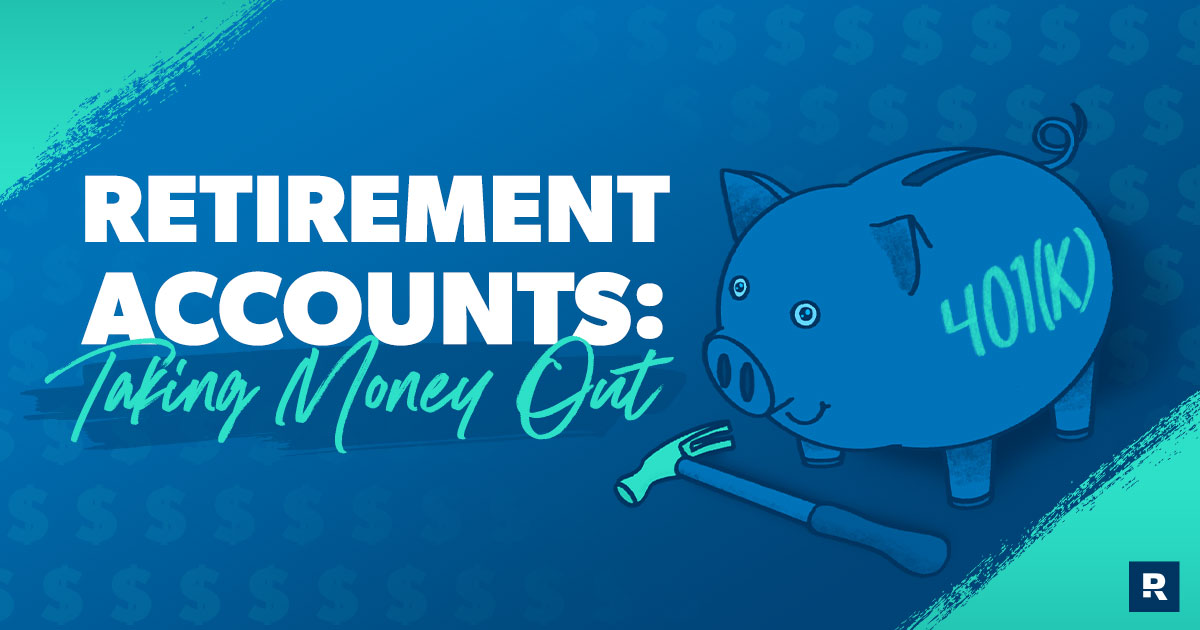How to Take Money Out of Retirement Accounts
7 Min Read | Sep 4, 2024

Congratulations! You’ve reached your retirement milestone, and you’re ready to live on your own terms! You can finally say goodbye to the daily grind and do what you’ve always wanted.
Now what?
7 Steps for Withdrawing Money From Your Retirement Account
The next hurdle is figuring out the process for taking money out of those retirement accounts you’ve been growing over time.
You may feel a little anxious about it, but don’t stress out. With some basic knowledge and the help of others, this process can be smooth sailing. In a nutshell, here are the steps:
- Work with a financial advisor to decide how much you have to take out. Seriously. Talking with a professional is worth the time, effort and brainpower. And it’ll save you a lot of stress too.
- Decide how you want to receive your money: in one lump sum or through a series of automatic withdrawals. Different investment accounts have different rules about withdrawals, so read the fine print.
- Contact the financial institution where your account is and let them know you’re ready to start withdrawing money. In some cases, you can do this online.
- The financial institution (or the website) will prepare paperwork for you.
- Read through the paperwork and ask questions about anything you don’t understand.
- Sign and return the paperwork.
- The financial institution will process the paperwork and give you the money.
Now, depending on the bank or brokerage company, you can knock out some or all of these steps in one visit. But you’ll need to allow time for the paperwork to process. Don’t expect to get your money immediately.
While you may not need to take out money to make ends meet just yet, the IRS requires you to take money out of some accounts at age 73 (if you turn 72 in 2023 or later).1 Again, the rules are different for various kinds of retirement accounts, so before you take any steps outlined above, make sure you understand how the IRS requirements apply to you.
As we walk through the basics, you’ll notice we use words like probably, could, might, likely and possibly. That’s because there are exceptions for just about every IRS rule. We can’t speak to your specific situation in an article, but you get the gist.
Taking Money From Traditional Retirement Accounts
Non-Roth IRA accounts—including traditional IRAs, SEP-IRAs, 401(k)s, 403(b)s, 457(b)s and SIMPLE IRAs—have a deadline for what’s called required minimum distributions (RMDs).2 The IRS sets a minimum amount that you have to withdraw from your accounts every year. That amount is based on your life expectancy and the amount of money you have saved in your non-Roth IRAs.3 The amount also changes every year.
To determine your RMD:
- Visit the IRS website to find your life expectancy.
- Divide the amount of money in your accounts by your life expectancy.
Let’s say you have $200,000 in a traditional IRA and start taking money out at age 73. According to the table provided by the IRS, you have a life expectancy of 26.5 years.
- $200,000 (amount in IRA) divided by 26.5 (life expectancy) = about $7,550 RMD for this year
In this example, your RMD would be roughly $7,550. When you take the money out, you’ll pay taxes on it because it wasn’t taxed when you put it into the account—which is why the government requires the withdrawal in the first place. Uncle Sam wants his share. You’re allowed to take out more than the minimum amount, but again, you pay taxes on it.
How much will you need for retirement? Find out with this free tool!
If you don’t take your RMD by the IRS deadline (at age 73) or you don’t take out enough money, that mistake will probably cost you a whopping 50% tax on the amount you should have taken out.4 Every year after that, you’re required to make the withdrawals by December 31.
Invest Like No One Else
From investing advice to wealth management, find a SmartVestor Pro who speaks your language.
Ramsey Solutions is a paid, non-client promoter of participating pros.
Taking Money From Roth Accounts
There are no RMDs for Roth IRAs.5 If you have a Roth IRA, you can take out money tax-free any time after age 59 1/2. You could keep the money in there indefinitely. But taking money from a Roth IRA doesn’t count toward your RMD for a traditional IRA.
Now, when it comes to Roth 401(k) and Roth 403(b) accounts, the rules are a bit different. For the rest of 2023, both these accounts are still subject to the outlined RMD rules. But, thanks to the SECURE 2.0 Act, RMDs for both these Roth accounts won’t be required starting in 2024.6
Since the withdrawal rules are in a funky transition period right now, it’s always smart to reach out to your financial advisor for all the important details. This way, you can navigate the changing withdrawal rules smoothly without getting on Uncle Sam’s radar.
Taking RMD Out of Multiple Accounts
If you have several IRAs, you don’t have to take the RMD out of each account. Instead, you can add up the RMDs from all of your accounts and take your RMD from one of those IRAs.7 The other option is to consolidate the multiple IRAs into one IRA.
But the same option doesn’t apply to traditional 401(k)s and similar plans. You have to withdraw the RMD from each 401(k).8 To make paperwork easier, you may be able to roll over multiple 401(k)s into a single IRA.
Keep Boosting Your Investing Know-How
Every two weeks, the Ramsey Investing Newsletter will send you practical insights, easy-to-use resources, and the latest investing news. All explained in plain English.
How You Can Use Your RMD
Now, listen up because this is important: Just because you’re required to take out money doesn’t mean you’re required to spend that money. Yes, you can use it for your living expenses and everyday needs, but that’s not your only option. Here are some other choices:
- Transfer the money into your checking account. From there, you can spend it as you wish.
- Transfer the money into a savings account.
- Transfer the money into a taxable investment account. You can invest the money in the mutual fund of your choice, but the money will be taxed just like income when you take it out. There are no special breaks.
- Do a direct rollover into another investment account (there are rules about this, so it’s not always an option).
- Send a check (up to $100,000) directly to a charity of your choice. It’ll count toward your RMD, and you won’t pay taxes on it.9 This option lowers your adjusted gross income for the year (which can affect how much you pay in taxes), but you can’t also deduct that money as a charitable contribution.
When you decide to take out that RMD, make sure it matches up with your budget needs. Yes, you’ll still need to budget in retirement. Don’t take out too much at once just because you can. You’ve worked too hard all this time to blow through your money and then have to go back to work!
Best Advice for Withdrawing Money
Here’s the bottom line, and it’s the honest truth: The IRS rules can make your head spin. They’re confusing, and they sound like they’re written by a Ph.D. scholar.
When it’s time to take out money from your retirement accounts, we recommend talking with your financial advisor instead of trying to go it alone. With a little budgeting prep and the help of a pro, you’ll be set to withdraw an amount that suits your needs and still lets you enjoy the hard-earned fruits of your labor—for the rest of your life.
Need help finding a qualified investment professional? Just enter your information, and you’ll get a list of SmartVestor Pros in your area to help you make a plan for your retirement.
This article provides general guidelines about investing topics. Your situation may be unique. To discuss a plan for your situation, connect with a SmartVestor Pro. Ramsey Solutions is a paid, non-client promoter of participating Pros.



